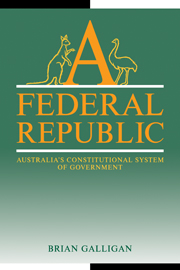Book contents
- Frontmatter
- Contents
- Tables and figures
- Preface
- Dedication
- Introduction
- 1 A federal republic
- 2 Federal theory and Australian federalism
- 3 The Senate and responsible government
- 4 Labor and the Australian Constitution
- 5 The referendum process
- 6 The protection of rights
- 7 The High Court and the Constitution
- 8 Intergovernmental relations and new federalism
- 9 Fiscal federalism
- 10 Towards and beyond 2001
- Bibliography
- Index
10 - Towards and beyond 2001
Published online by Cambridge University Press: 05 November 2011
- Frontmatter
- Contents
- Tables and figures
- Preface
- Dedication
- Introduction
- 1 A federal republic
- 2 Federal theory and Australian federalism
- 3 The Senate and responsible government
- 4 Labor and the Australian Constitution
- 5 The referendum process
- 6 The protection of rights
- 7 The High Court and the Constitution
- 8 Intergovernmental relations and new federalism
- 9 Fiscal federalism
- 10 Towards and beyond 2001
- Bibliography
- Index
Summary
Federalism and the new world order
Federalism is a venerable structure of government with institutional links going back to ancient times. With a modern history of more than two hundred years from the drafting and ratification of the Constitution of the United States in 1787, the American model now has a central position in discussions of federalism because of the dominance of the United States in world politics, especially since World War II, and the coherency of the American Federalist argument, which gave federalism a rationale for democratic republicanism (Diamond 1961; Wheare [1946] 1963).
A somewhat different tradition of European federalism was manifest in Switzerland, so that when the Australian Constitution was drafted in the 1890s it incorporated elements of both the American and Swiss models as well as being influenced by the Canadian hybrid of federalism and parliamentary responsible government. The postwar constitution of the Federal Republic of Germany was heavily influenced by the American model but also drew on a long national tradition of federalism (vonBeyme 1988).
Federalism was used extensively by imperialist European powers in cobbling together incongruous ethnic and tribal amalgamations to cover their belated withdrawals from Africa and Asia in the 1950s and 1960s. Despite its failure in such instances (Franck 1968), however, federalism in one form or another remains the institutional basis of numerous systems of government around the world (Elazar 1987: 43–4).
- Type
- Chapter
- Information
- A Federal RepublicAustralia's Constitutional System of Government, pp. 239 - 254Publisher: Cambridge University PressPrint publication year: 1995

